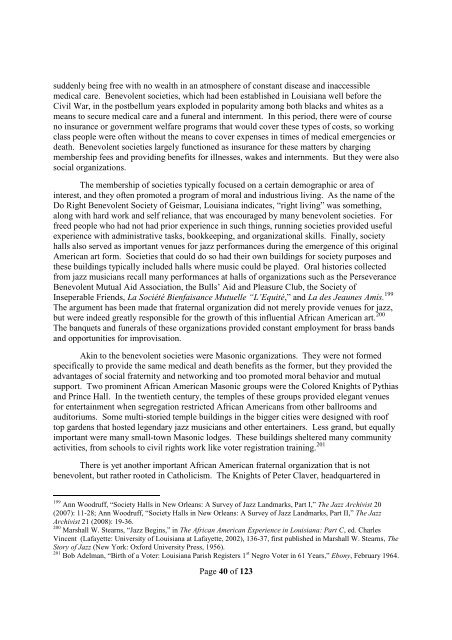The African American Experience in Louisiana
The_African_American_Experience_in_Louisiana
The_African_American_Experience_in_Louisiana
- No tags were found...
Create successful ePaper yourself
Turn your PDF publications into a flip-book with our unique Google optimized e-Paper software.
suddenly be<strong>in</strong>g free with no wealth <strong>in</strong> an atmosphere of constant disease and <strong>in</strong>accessible<br />
medical care. Benevolent societies, which had been established <strong>in</strong> <strong>Louisiana</strong> well before the<br />
Civil War, <strong>in</strong> the postbellum years exploded <strong>in</strong> popularity among both blacks and whites as a<br />
means to secure medical care and a funeral and <strong>in</strong>ternment. In this period, there were of course<br />
no <strong>in</strong>surance or government welfare programs that would cover these types of costs, so work<strong>in</strong>g<br />
class people were often without the means to cover expenses <strong>in</strong> times of medical emergencies or<br />
death. Benevolent societies largely functioned as <strong>in</strong>surance for these matters by charg<strong>in</strong>g<br />
membership fees and provid<strong>in</strong>g benefits for illnesses, wakes and <strong>in</strong>ternments. But they were also<br />
social organizations.<br />
<strong>The</strong> membership of societies typically focused on a certa<strong>in</strong> demographic or area of<br />
<strong>in</strong>terest, and they often promoted a program of moral and <strong>in</strong>dustrious liv<strong>in</strong>g. As the name of the<br />
Do Right Benevolent Society of Geismar, <strong>Louisiana</strong> <strong>in</strong>dicates, “right liv<strong>in</strong>g” was someth<strong>in</strong>g,<br />
along with hard work and self reliance, that was encouraged by many benevolent societies. For<br />
freed people who had not had prior experience <strong>in</strong> such th<strong>in</strong>gs, runn<strong>in</strong>g societies provided useful<br />
experience with adm<strong>in</strong>istrative tasks, bookkeep<strong>in</strong>g, and organizational skills. F<strong>in</strong>ally, society<br />
halls also served as important venues for jazz performances dur<strong>in</strong>g the emergence of this orig<strong>in</strong>al<br />
<strong>American</strong> art form. Societies that could do so had their own build<strong>in</strong>gs for society purposes and<br />
these build<strong>in</strong>gs typically <strong>in</strong>cluded halls where music could be played. Oral histories collected<br />
from jazz musicians recall many performances at halls of organizations such as the Perseverance<br />
Benevolent Mutual Aid Association, the Bulls’ Aid and Pleasure Club, the Society of<br />
Inseperable Friends, La Société Bienfaisance Mutuelle “L’Equité,” and La des Jeaunes Amis. 199<br />
<strong>The</strong> argument has been made that fraternal organization did not merely provide venues for jazz,<br />
but were <strong>in</strong>deed greatly responsible for the growth of this <strong>in</strong>fluential <strong>African</strong> <strong>American</strong> art. 200<br />
<strong>The</strong> banquets and funerals of these organizations provided constant employment for brass bands<br />
and opportunities for improvisation.<br />
Ak<strong>in</strong> to the benevolent societies were Masonic organizations. <strong>The</strong>y were not formed<br />
specifically to provide the same medical and death benefits as the former, but they provided the<br />
advantages of social fraternity and network<strong>in</strong>g and too promoted moral behavior and mutual<br />
support. Two prom<strong>in</strong>ent <strong>African</strong> <strong>American</strong> Masonic groups were the Colored Knights of Pythias<br />
and Pr<strong>in</strong>ce Hall. In the twentieth century, the temples of these groups provided elegant venues<br />
for enterta<strong>in</strong>ment when segregation restricted <strong>African</strong> <strong>American</strong>s from other ballrooms and<br />
auditoriums. Some multi-storied temple build<strong>in</strong>gs <strong>in</strong> the bigger cities were designed with roof<br />
top gardens that hosted legendary jazz musicians and other enterta<strong>in</strong>ers. Less grand, but equally<br />
important were many small-town Masonic lodges. <strong>The</strong>se build<strong>in</strong>gs sheltered many community<br />
activities, from schools to civil rights work like voter registration tra<strong>in</strong><strong>in</strong>g. 201<br />
<strong>The</strong>re is yet another important <strong>African</strong> <strong>American</strong> fraternal organization that is not<br />
benevolent, but rather rooted <strong>in</strong> Catholicism. <strong>The</strong> Knights of Peter Claver, headquartered <strong>in</strong><br />
199 Ann Woodruff, “Society Halls <strong>in</strong> New Orleans: A Survey of Jazz Landmarks, Part I,” <strong>The</strong> Jazz Archivist 20<br />
(2007): 11-28; Ann Woodruff, “Society Halls <strong>in</strong> New Orleans: A Survey of Jazz Landmarks, Part II,” <strong>The</strong> Jazz<br />
Archivist 21 (2008): 19-36.<br />
200 Marshall W. Stearns, “Jazz Beg<strong>in</strong>s,” <strong>in</strong> <strong>The</strong> <strong>African</strong> <strong>American</strong> <strong>Experience</strong> <strong>in</strong> <strong>Louisiana</strong>: Part C, ed. Charles<br />
V<strong>in</strong>cent (Lafayette: University of <strong>Louisiana</strong> at Lafayette, 2002), 136-37, first published <strong>in</strong> Marshall W. Stearns, <strong>The</strong><br />
Story of Jazz (New York: Oxford University Press, 1956).<br />
201 Bob Adelman, “Birth of a Voter: <strong>Louisiana</strong> Parish Registers 1 st Negro Voter <strong>in</strong> 61 Years,” Ebony, February 1964.<br />
Page 40 of 123


